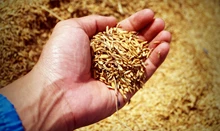
This article is an extention of our previous article written by Dr. Vivek Kumar Singh. We suggest you to read the previous two article to understand this knowledge piece in a better form.
In this article, we will talk about the harvesting operations which will give the farmer maximum returns.
Harvesting operations
In order to maintain high purity, extreme care should be taken at harvesting and threshing. Just before harvesting, check female rows for left-over pollen shedders (i.e. maintainer plants), off-types and male parent plants (restorers). After confirmation that the field does not contain unwanted plants, the male rows should be harvested first and all panicles carefully removed. Move the harvested male plants to a separate threshing floor where only male parents should be threshed. The female rows which are ready for harvest should be carefully rechecked for left-over plants or panicles of male (restorer) parents. Female plants should then be harvested and threshed on a separate threshing floor. The threshing floor should be free from seed of the previous crop and must be very clean. Threshing can be done by a harvest combiner, thresher, tractor or bullocks. With the harvest combiner or thresher, extreme care must be taken to clean the machine thoroughly before use, so as to avoid admixture with other varieties of paddy.
After threshing, the seed should be properly dried and bagged. The bags need to have labels inside and outside, listing all necessary details, such as lot identification or lot number, date of harvest and quantity of lot.
Seed quality
Seed is an important and basic input for achieving higher crop yield and increasing a country’s agricultural economy. Thus it is very important to maintain seed quality by understanding the right mechanism. Seed quality means preserving and maintaining physical and genetic purity. Normal standards for genetic purity are given in Table 1.
TABLE 1
Standards for genetic purity
|
Class of seed |
Minimum genetic purity in percentage |
|
Breeder seed |
100.00 |
|
Foundation seed |
99.50 |
|
Commercial hybrid seed - physical purity |
98.00 |
|
Genetic purity |
95.00 |

Seed arrivals and processing
As soon as seed arrives at the seed processing plant from seed production areas, lot-wise seed weighing of every bag should be recorded and lot-wise representative samples drawn. These samples should be used for laboratory testing of germination percentage, moisture percentage, physical purity and seed viability. Based on the test results, the seed from good lots should be processed in the seed conditioning plant.
Seed conditioning
Seed conditioning or processing should be done one hybrid at a time. Extreme care should be taken before beginning work in the seed processing plant. The processing plant must be cleaned thoroughly for any left-over seed from an earlier processed variety or hybrid, so as to avoid contamination. In order to maintain good quality standards, the seed is passed through several machines:
Pre-cleaner: eliminates inert matter (chaffy seed, big stones etc.) and reduces the workload of the cleaner.
Cleaner: eliminates remaining inert matter in the seed (sand, fine dust, chaffy seed and undersized or small seed).
De-stoner: separates mud balls, small stones etc., which are heavier than the seed, using higher specific gravitational force.
Gravity separator: separates light from heavy seed; seed is then of uniform size and clean.
Treator: seed is treated with the right proportions of chemicals (Thiram, Chlorophyriphos, Sevin, K-Obiol etc.).
The seed is then packed as “truthfully labelled”. The label contains information such as: physical purity percentage (min.); genetic purity percentage (min.); inert matter percentage (max.); other crop seed percentage (max.); weed seed number/kg (max.); germination percentage (min.); and moisture percentage (max.).
SEED PRODUCTION OF A LINE
For nucleus seed production of A line, the originating breeder hand-crosses true-to-type A/B plants.
For breeder seed production of A line, the breeder plants A/B rows in a ratio of 2 female: 2 male rows with a minimum isolation distance of 200 m. Timely roughing of the plot is carried out at various crop growth stages from vegetative to harvesting.
For foundation seed production of A line, the process is supervised by a foundation seed expert. The seedlings are planted in a ratio of 4 female: 2 male rows with a minimum isolation distance of 150 m. There are normally two sowings of the male line, sowing the B line 3 and 6 days after the female line.
SEED PRODUCTION OF B AND R LINES
Nucleus, breeder and foundation seed of B and R lines are multiplied adopting practices similar to those used for conventional varieties. However, care must be taken not to harvest B and R line seed from A/B or A/R seed production plots. Separate multiplication of B and R line plots helps maintain purity and produce quality seeds.













Share your comments